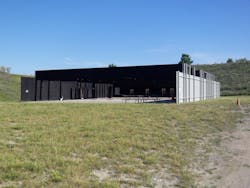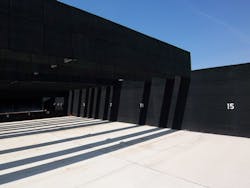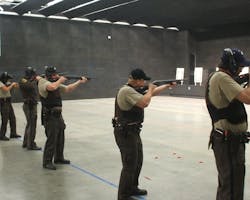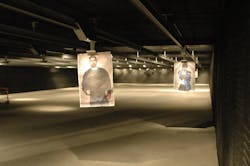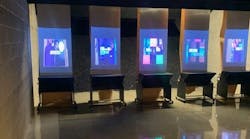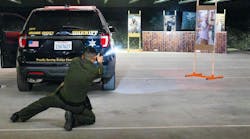One of the most serious responsibilities law enforcement instructors carry is making sure they’ve adequately prepared their cadets to survive the streets before they graduate from the academy. After the months of academy training, those cadets go out and work under the supervision of a field training officer (FTO) before they are allowed to work alone. Many trainers/instructors consider that FTO period as part of the training portion of a rookie officer’s career, and it is. There’s also the very stark reality that a rookie officer who just graduated from the academy can be in a lethal force situation during their first shift. That isn’t the time to be learning judgment, self-confidence, the value of moving, communicating and more. While all of the other skills related to professional law enforcement performance can be honed during the FTO program, the firearms and use-of-force skills have to be 100 percent before the rookie graduates from the academy. The challenge instructors face is taking a fresh-faced recruit who has never so much as held a gun and training them to be not only competent in the use of firearms but with the requisite knowledge, judgment and shooting skills to not only survive an encounter but emerge victorious. Additionally, they have to be able to survive the inevitable investigation and potential prosecution/litigation afterwards.
Aim for subconscious competence
The goal of a complete firearms training program should be to take the cadet from being completely incompetent (you have to assume that) to completely competent in every foreseeable circumstance. To understand the task at hand, we need to understand the four levels of competency:
Unconsciously incompetent: This means the cadet doesn’t even have an awareness of the knowledge and skills they need. They are unaware of their incompetence.
Consciously incompetent: This is the level where the cadet is aware of what they need to learn but has not yet learned or mastered it. This applies to both knowledge and skills.
Consciously competent: This is the level where the cadet can articulate knowledge objectives and demonstrate skill objectives but only with conscious thought and given sufficient time to consider all circumstances.
Subconsciously competent: This is the level we want them to attain. At this level they have mastered all knowledge and skill objectives sufficiently and they can perform them without conscious thought in response to a given stimulus and in a very limited time frame. In fact, since we’re talking about lethal force, the less time, the better.
Interestingly, the goal of a firearms training program hasn’t changed in quite some time. While the tools and technologies available are vastly different today than they were 50 years ago, the end goal is the same—to train the cadet to properly and safely use the firearm to protect and defend their own life and the lives of innocents; to do so within the legal limitations of federal and state law as well as departmental policy; to do so justly, morally and with the ability to clearly articulate why after the fact; to survive and emerge victorious from a lethal threat situation and to do so without undo emotional or mental trauma. To train a cadet to this level of performance is the instructor’s goal and responsibility.
How do you go about taking someone who has no knowledge of firearms and train them across a four to six month period to be of such a competence level? First, and this may be a battle you fight with your command staff, you need sufficient time allotted. The training will require classroom time, range time, shoot house time and judgmental (force-on-force) training areas. It will require quite a bit of ammunition, all of the requisite safety and cleaning supplies, and the necessary number of properly certified staff instructors. In the classroom you can get away with one instructor (depending on the topic material being taught), but on the range you have to pay strict attention to your instructor/student ratio, and (sometimes surprisingly) the number of instructors needed for force-on-force training is even greater than the number needed for the range.
Let’s start with the basics
Remember that as you train these cadets in the classroom, you’re not just teaching them what they need to know to operate their own weapon, but you have a responsibility to teach them about other weapons they might commonly face on the street. While every large department in the country today is issuing or authorizing semi-automatic handguns, there are still plenty of revolvers on the street (NYPD just recently finally decided to phase them out completely). In addition to the handguns you need to cover, you also need to teach shotguns and rifles as appropriate for your agency. Do you have enough classroom time allotted to cover all that? Do you have the necessary staff to assist in the classroom?
The classroom portion of your training has to cover functionality, field stripping, inspection, cleaning, reassembly and function testing of each weapon the cadet will eventually be issued or authorized. Absolutely no live ammunition should be in the classroom for this training. The classroom training should, at a minimum, cover the issued handgun, the department long gun (shotgun or rifle) and any additional weapons the agency authorizes as secondary or off-duty weapons. This means that your instructor staff will have to hold competency beyond just the agency’s duty weapon or authorized weapons. The reason you need more than one instructor is because there will inevitably be questions asked, assistance needed and, for the sake of time efficiency, there should be one instructor per ten cadets (as a general goal number). More is better and fewer can potentially be managed depending on time constraints.
The classroom training should also include how to load magazines, unload magazines, and load and unload the weapon. In the classroom, this part of the training should be done with dummy rounds not live ammo. Under no circumstances should live ammo be in the classroom.
Once the cadets have all demonstrated proper understanding of operating the weapon in the classroom, the basics of marksmanship have to be taught. Stance, grip, sight alignment, sight picture, breath control, trigger press and follow-through all have to be explained to and understood by the cadets. With empty weapons, these knowledge objectives can then be converted to demonstrated skill—stance, grip, sight alignment and sight picture. Breath control can be taught but you can’t teach trigger press without violating a few basic safety rules. That should wait for the range.
At least one long-time firearms instructor has suggested that every cadet be issued their gunbelt along with a firearm replica at the very beginning of the academy. Further, it was suggested that the basics of marksmanship including stance, grip, sight alignment and sight picture be taught along with the concepts of cover and verbal commands. That instructor recommended then having the cadets be trained so that any time an instructor – at any time, anywhere in the academy – yelled, “THREAT!” the cadets would seek cover, draw and present their firearms. They then would be critiqued, as practical, on their grip and presentation.
From the classroom to the range
From the classroom and with those objectives all met, it’s time to go out to the range. Cadets have to understand the mechanics of drawing and presenting their weapons as well as loading, unloading and basic marksmanship. There will be the inevitable coaching as the cadets learn proper stance, grip, sight alignment, sight picture, breath control, trigger press and follow-through. Correcting flinching is usually a big challenge but the little things like mounting the weapon properly and trigger finger placement have to be addressed. Remember, for each of these training evolutions you perform with the handgun, you have to do the same with the shotgun, rifle or other weapons.Once the cadet has demonstrated their ability to put reasonably sized groups on a paper target you have to incorporate stress prior to shooting. When the cadet can still shoot those groups with an accelerated heart rate and within restricted time limits, then you need to teach malfunction corrections, wounded shooter skills, shooting while moving and, all throughout, you need to ensure that the cadet understands and demonstrates the need to both seek cover and convey verbal coherent verbal commands.
When your cadets have demonstrated competency in all of that, it’s time to introduce moving and reactionary targets.
Introducing moving targets
This is a great time to introduce some competitiveness and “games.” This is the stage where your cadet’s competency is moving from being consciously competent to being subconsciously competent. Those basic skills are becoming second nature, as the cadet has performed so many repetitions of each given mechanical and knowledge/judgmental skill that they are no longer having to think about what they’re doing but are doing it in response to a given stimulus. This is also a higher risk time in the training as the cadets may be more apt to commit seemingly small errors in handling or judgment, and those “small errors” can have quite serious, even fatal, consequences. Where the instructor/shooter ratio can be 1/10 during basic marksmanship training shooting on non-moving paper targets, when you start adding in a lot of movement, time limits, malfunction drills and more, the instructor/student ratio has to become 1/1 at times.
Cadets tend to enjoy shooting on reactive targets. Steel takes maintenance and has increased safety considerations related to shrapnel and shooter distance. Be sure to take all that into consideration. Balloons can create their own challenges with movement dependent on wind and how they are secured, but those challenges can create greater skill levels with the cadets as well. Balloons also carry a limited threat to the environment and certain animals, so a thorough cleanup is required.
When it comes to target systems, a proper LE training facility should have systems that allow for decision-making and situational awareness, according to Brad Ross, director of brand marketing at Range Systems. “This includes systems that turn the targets on edge and then face the officer with shoot/don’t shoot scenarios. This trains the officers to quickly and accurately identify the situation and react accordingly in a controlled environment.” He notes that other elements that are important for training is the ability for the officer to do “off the mark” training. “The range should be set up to allow for non-traditional training, which includes shooting from behind cover and the ability to shoot at various angles and distances.”
Skills beyond the range
There comes a point where the cadets have demonstrated sufficient shooting skill; they have reached the fourth level of competency and now you have to teach them judgment and tactical geometry. They have to be taught when to pull the trigger or not, dependent on the totality of the circumstances (judgment) and how to move through or around obstacles to search or secure areas (tactical geometry). To teach these skills you need a shoot house or other secured area where the cadets can train with firearm replicas and weapons converted for training ammunition.
Teaching tactical geometry is logistically difficult but practically simple. Creating the properly controlled training space, ensuring proper safety protocols and choreographing your training assistants are the logistical challenges. Coordinating all of these concerns and documenting such can be a headache but can’t be shortchanged. The mechanics are easier. The cadets are given an assignment of clearing a building or searching a given area. They’ve been taught the skills and need to demonstrate understanding/application. In doing so, if they make mistakes, role players can deliver “educational stimulus” by firing simunitions equipped training weapons at them. Pain penalties are indeed a great training stimulus but must not be used unprofessionally.
After action reviews (AARs) and performance critiques are where 80 percent of the learning occurs in these scenario-based evolutions and should be documented for defense down the road if it ever becomes necessary.
To teach judgment, you can certainly make use of the many projection scenario-based systems, but typically they present no threat to the student and unless you can simulate the return threat, the cadet’s learning will be limited. The sympathetic nervous system needs to be stimulated and that means presenting some type of threat—a pain penalty of some kind. The scenarios need to be carefully controlled and dynamic so that the instructor has some means of adjusting the threat from moment to moment. The cadets need to be put in scenarios and overall circumstances that demonstrate the constant fast-changing conditions of real life lethal force encounters.
After each scenario, assuming successful completion with correct judgment and good shot placement, each cadet needs to be debriefed and taught how to articulate the need for the use-of-force delivered. This is absolutely mandatory if the cadet is going to survive a career that will include severe and unjust criticism of any use-of-force. The cadet has to be taught the laws that govern use-of-force and then how to articulate the use-of-force in compliance with those laws. Further, the cadet needs to thoroughly understand which laws protect them legally and when to exercise any protections offered.
A proper and thorough firearms training program spans many physical areas and creates a big time, budget and training staff demand. It’s not something that should be undertaken with a devil-may-care attitude and it absolutely cannot be done in any way but with 100 percent dedication to proper completion. Your cadets and future officers depend on it to keep them alive and you depend on it to keep your agency maintaining a professional image. Do it right.
